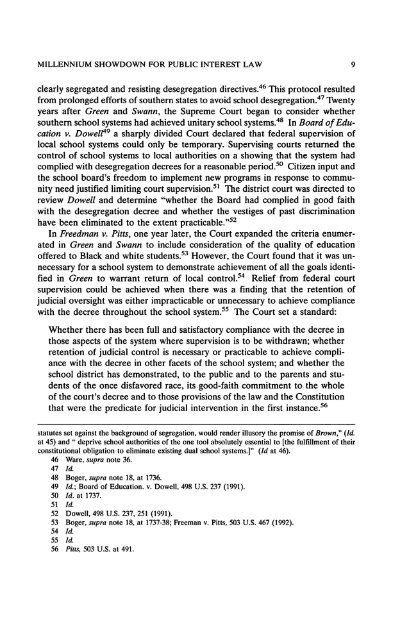Download Electronic Version - UDC Law Review
Download Electronic Version - UDC Law Review
Download Electronic Version - UDC Law Review
You also want an ePaper? Increase the reach of your titles
YUMPU automatically turns print PDFs into web optimized ePapers that Google loves.
MILLENNIUM SHOWDOWN FOR PUBLIC INTEREST LAW 9<br />
clearly segregated and resisting desegregation directives. 46 This protocol resulted<br />
from prolonged efforts of southern states to avoid school desegregation. 47 1\venty<br />
years after Green and Swann, the Supreme Court began to consider whether<br />
southern school systems had achieved unitary school systems. 48 In Board of Education<br />
v. Dowe1l 49 a sharply divided Court declared that federal supervision of<br />
local school systems could only be temporary. Supervising courts returned the<br />
control of school systems to local authorities on a showing that the system had<br />
complied with desegregation decrees for a reasonable period. 50 Citizen input and<br />
the school board's freedom to implement new programs in response to community<br />
need justified limiting court supervision. 51 The district court was directed to<br />
review Dowell and determine "whether the Board had complied in good faith<br />
with the desegregation decree and whether the vestiges of past discrimination<br />
have been eliminated to the extent practicable. ,,52<br />
In Freedman v. Pitts, one year later, the Court expanded the criteria enumerated<br />
in Green and Swann to include consideration of the quality of education<br />
offered to Black and white students. 53 However, the Court found that it was unnecessary<br />
for a school system to demonstrate achievement of all the goals identified<br />
in Green to warrant return of local control. 54 Relief from federal court<br />
supervision could be achieved when there was a finding that the retention of<br />
judicial oversight was either impracticable or unnecessary to achieve compliance<br />
with the decree throughout the school system. 55 The Court set a standard:<br />
Whether there has been full and satisfactory compliance with the decree in<br />
those aspects of the system where supervision is to be withdrawn; whether<br />
retention of judicial control is necessary or practicable to achieve compliance<br />
with the decree in other facets of the school system; and whether the<br />
school district has demonstrated, to the public and to the parents and students<br />
of the once disfavored race, its good-faith commitment to the whole<br />
of the court's decree and to those provisions of the law and the Constitution<br />
that were the predicate for judicial intervention in the first instance. 56<br />
statutes set against the background of segregation, would render illusory the promise of Brown," (Id.<br />
at 45) and" deprive school authorities of the one tool absolutely essential to [the fulfillment of their<br />
constitutional obligation to eliminate existing dual school systems.]" (Id at 46).<br />
46 Ware, supra note 36.<br />
47 Id.<br />
48 Boger, supra note 18, at 1736.<br />
49 Id.; Board of Education. v. Dowell, 498 U.S. 237 (1991).<br />
50 Id. at 1737.<br />
51 Id.<br />
52 Dowell, 498 U.S. 237, 251 (1991).<br />
53 Boger, supra note 18, at 1737-38; Freeman v. Pitts, 503 U.S. 467 (1992).<br />
54 Id.<br />
55 Id.<br />
56 Pitts, 503 U.S. at 491.














